Starbucks Case Study: CSR, Value Change & Global Growth Strategies
VerifiedAdded on 2023/04/22
|10
|2330
|398
Case Study
AI Summary
This case study analyzes Starbucks' approach to corporate social responsibility (CSR) and value change, examining its stakeholder management and global growth strategies. The first part explores Starbucks' CSR initiatives, considering stakeholder theory and different CSR viewpoints, highlighting the company's socioeconomic view and providing recommendations for improvement. The second part discusses Starbucks' value change, particularly in relation to stock prices, revenue growth, and shareholder dividends, also offering recommendations for enhancing stakeholder engagement and operational efficiency. The case study emphasizes the importance of balancing profit generation with sustainability and stakeholder interests for sustained competitive advantage. Desklib provides access to similar case studies and solved assignments to aid students in their studies.
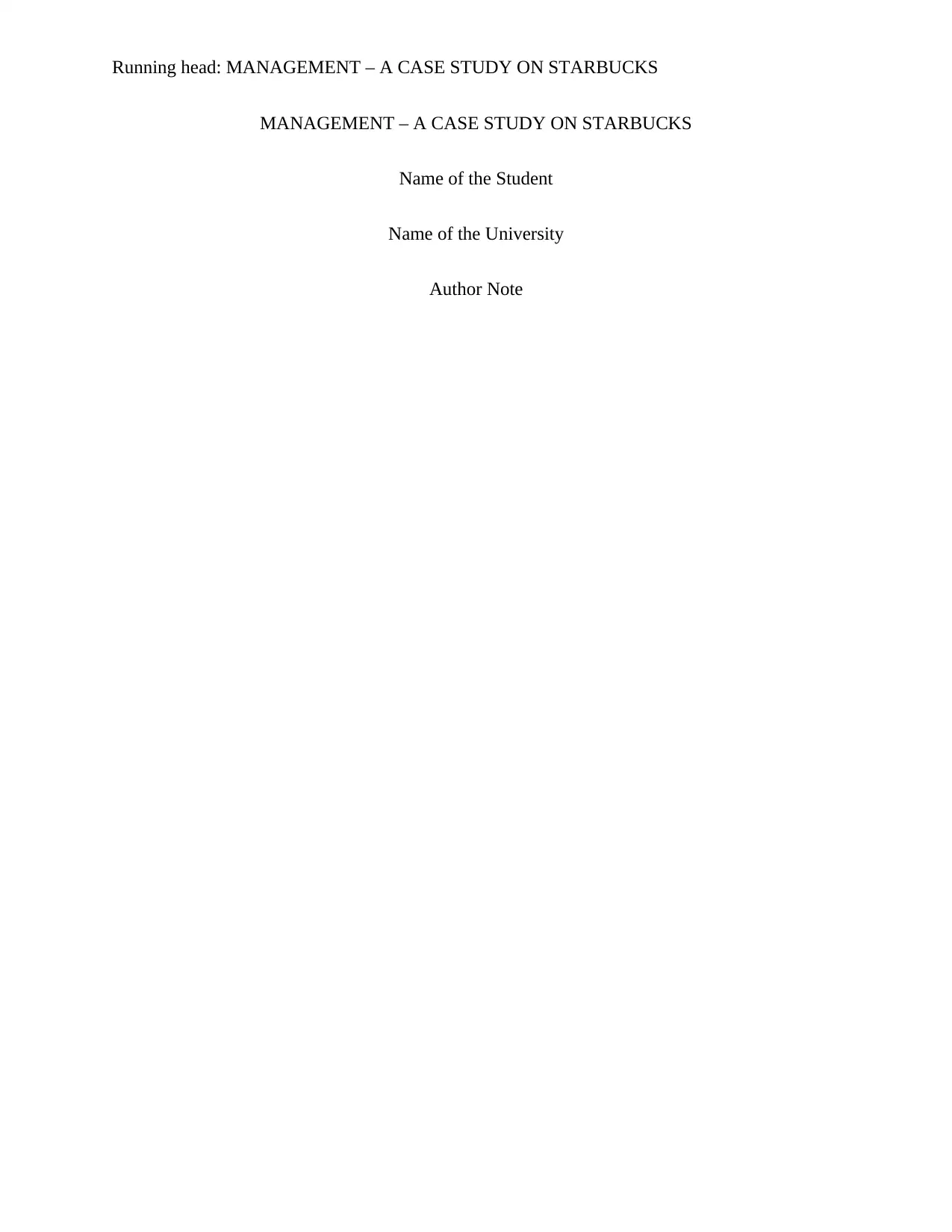
Running head: MANAGEMENT – A CASE STUDY ON STARBUCKS
MANAGEMENT – A CASE STUDY ON STARBUCKS
Name of the Student
Name of the University
Author Note
MANAGEMENT – A CASE STUDY ON STARBUCKS
Name of the Student
Name of the University
Author Note
Paraphrase This Document
Need a fresh take? Get an instant paraphrase of this document with our AI Paraphraser
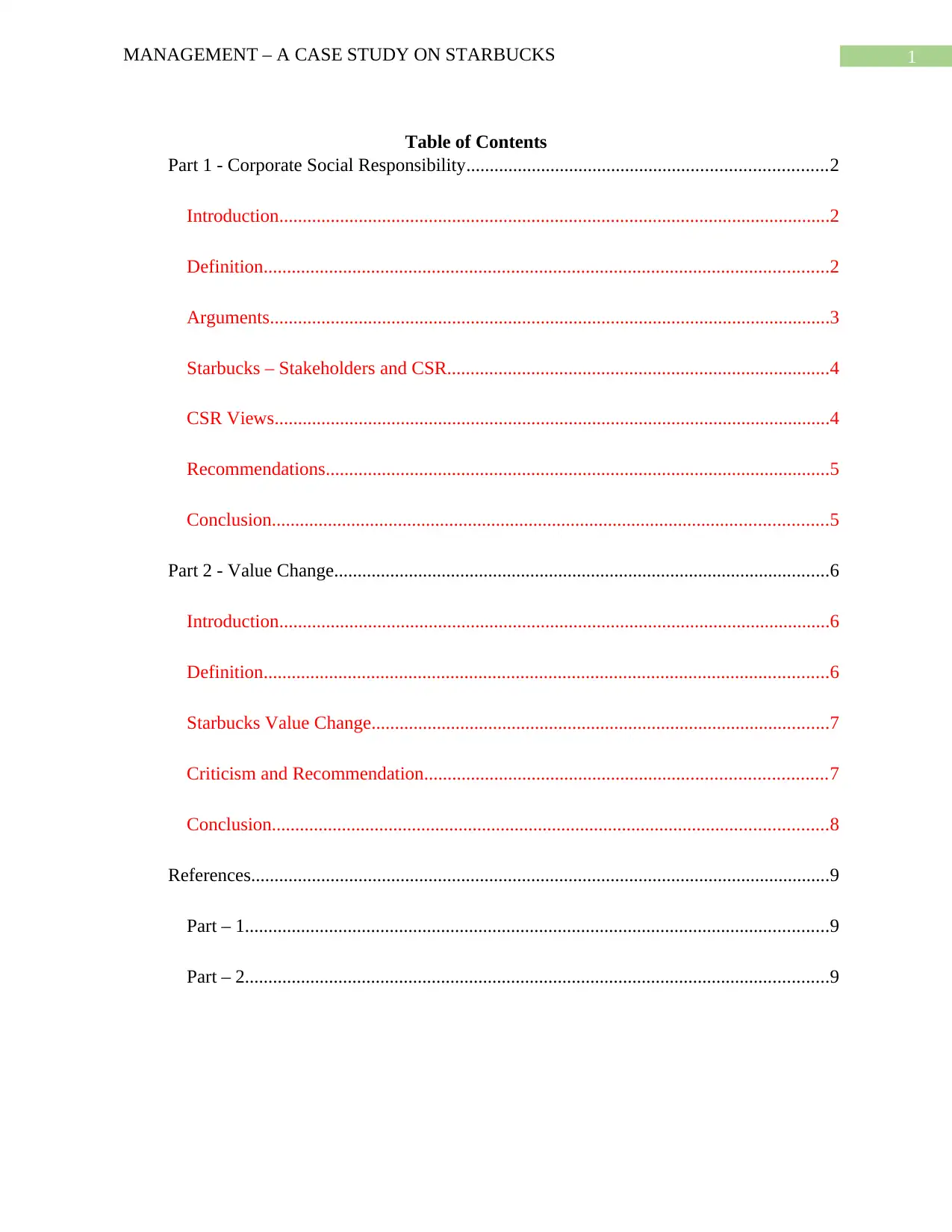
1MANAGEMENT – A CASE STUDY ON STARBUCKS
Table of Contents
Part 1 - Corporate Social Responsibility.............................................................................2
Introduction......................................................................................................................2
Definition.........................................................................................................................2
Arguments........................................................................................................................3
Starbucks – Stakeholders and CSR..................................................................................4
CSR Views.......................................................................................................................4
Recommendations............................................................................................................5
Conclusion.......................................................................................................................5
Part 2 - Value Change..........................................................................................................6
Introduction......................................................................................................................6
Definition.........................................................................................................................6
Starbucks Value Change..................................................................................................7
Criticism and Recommendation......................................................................................7
Conclusion.......................................................................................................................8
References............................................................................................................................9
Part – 1.............................................................................................................................9
Part – 2.............................................................................................................................9
Table of Contents
Part 1 - Corporate Social Responsibility.............................................................................2
Introduction......................................................................................................................2
Definition.........................................................................................................................2
Arguments........................................................................................................................3
Starbucks – Stakeholders and CSR..................................................................................4
CSR Views.......................................................................................................................4
Recommendations............................................................................................................5
Conclusion.......................................................................................................................5
Part 2 - Value Change..........................................................................................................6
Introduction......................................................................................................................6
Definition.........................................................................................................................6
Starbucks Value Change..................................................................................................7
Criticism and Recommendation......................................................................................7
Conclusion.......................................................................................................................8
References............................................................................................................................9
Part – 1.............................................................................................................................9
Part – 2.............................................................................................................................9
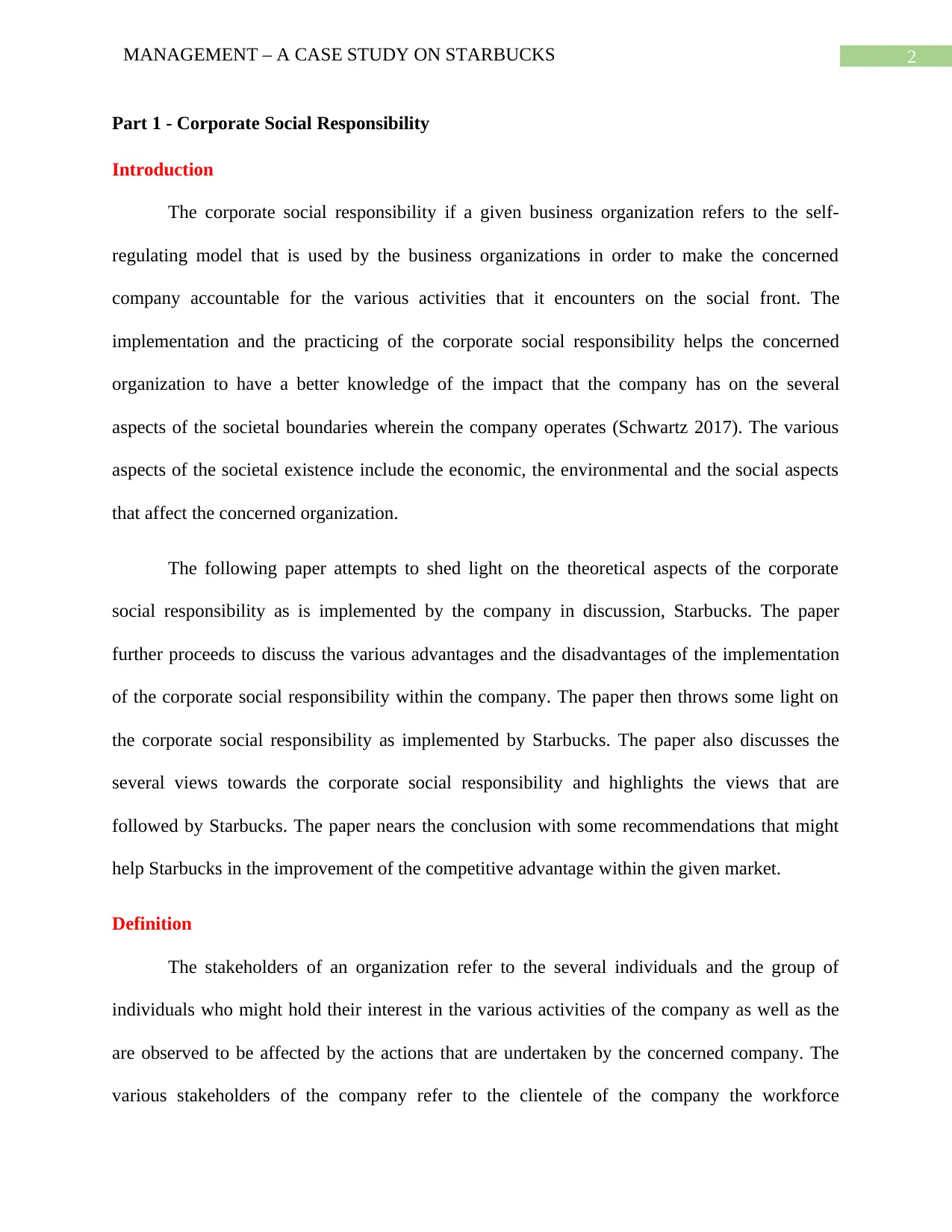
2MANAGEMENT – A CASE STUDY ON STARBUCKS
Part 1 - Corporate Social Responsibility
Introduction
The corporate social responsibility if a given business organization refers to the self-
regulating model that is used by the business organizations in order to make the concerned
company accountable for the various activities that it encounters on the social front. The
implementation and the practicing of the corporate social responsibility helps the concerned
organization to have a better knowledge of the impact that the company has on the several
aspects of the societal boundaries wherein the company operates (Schwartz 2017). The various
aspects of the societal existence include the economic, the environmental and the social aspects
that affect the concerned organization.
The following paper attempts to shed light on the theoretical aspects of the corporate
social responsibility as is implemented by the company in discussion, Starbucks. The paper
further proceeds to discuss the various advantages and the disadvantages of the implementation
of the corporate social responsibility within the company. The paper then throws some light on
the corporate social responsibility as implemented by Starbucks. The paper also discusses the
several views towards the corporate social responsibility and highlights the views that are
followed by Starbucks. The paper nears the conclusion with some recommendations that might
help Starbucks in the improvement of the competitive advantage within the given market.
Definition
The stakeholders of an organization refer to the several individuals and the group of
individuals who might hold their interest in the various activities of the company as well as the
are observed to be affected by the actions that are undertaken by the concerned company. The
various stakeholders of the company refer to the clientele of the company the workforce
Part 1 - Corporate Social Responsibility
Introduction
The corporate social responsibility if a given business organization refers to the self-
regulating model that is used by the business organizations in order to make the concerned
company accountable for the various activities that it encounters on the social front. The
implementation and the practicing of the corporate social responsibility helps the concerned
organization to have a better knowledge of the impact that the company has on the several
aspects of the societal boundaries wherein the company operates (Schwartz 2017). The various
aspects of the societal existence include the economic, the environmental and the social aspects
that affect the concerned organization.
The following paper attempts to shed light on the theoretical aspects of the corporate
social responsibility as is implemented by the company in discussion, Starbucks. The paper
further proceeds to discuss the various advantages and the disadvantages of the implementation
of the corporate social responsibility within the company. The paper then throws some light on
the corporate social responsibility as implemented by Starbucks. The paper also discusses the
several views towards the corporate social responsibility and highlights the views that are
followed by Starbucks. The paper nears the conclusion with some recommendations that might
help Starbucks in the improvement of the competitive advantage within the given market.
Definition
The stakeholders of an organization refer to the several individuals and the group of
individuals who might hold their interest in the various activities of the company as well as the
are observed to be affected by the actions that are undertaken by the concerned company. The
various stakeholders of the company refer to the clientele of the company the workforce
⊘ This is a preview!⊘
Do you want full access?
Subscribe today to unlock all pages.

Trusted by 1+ million students worldwide
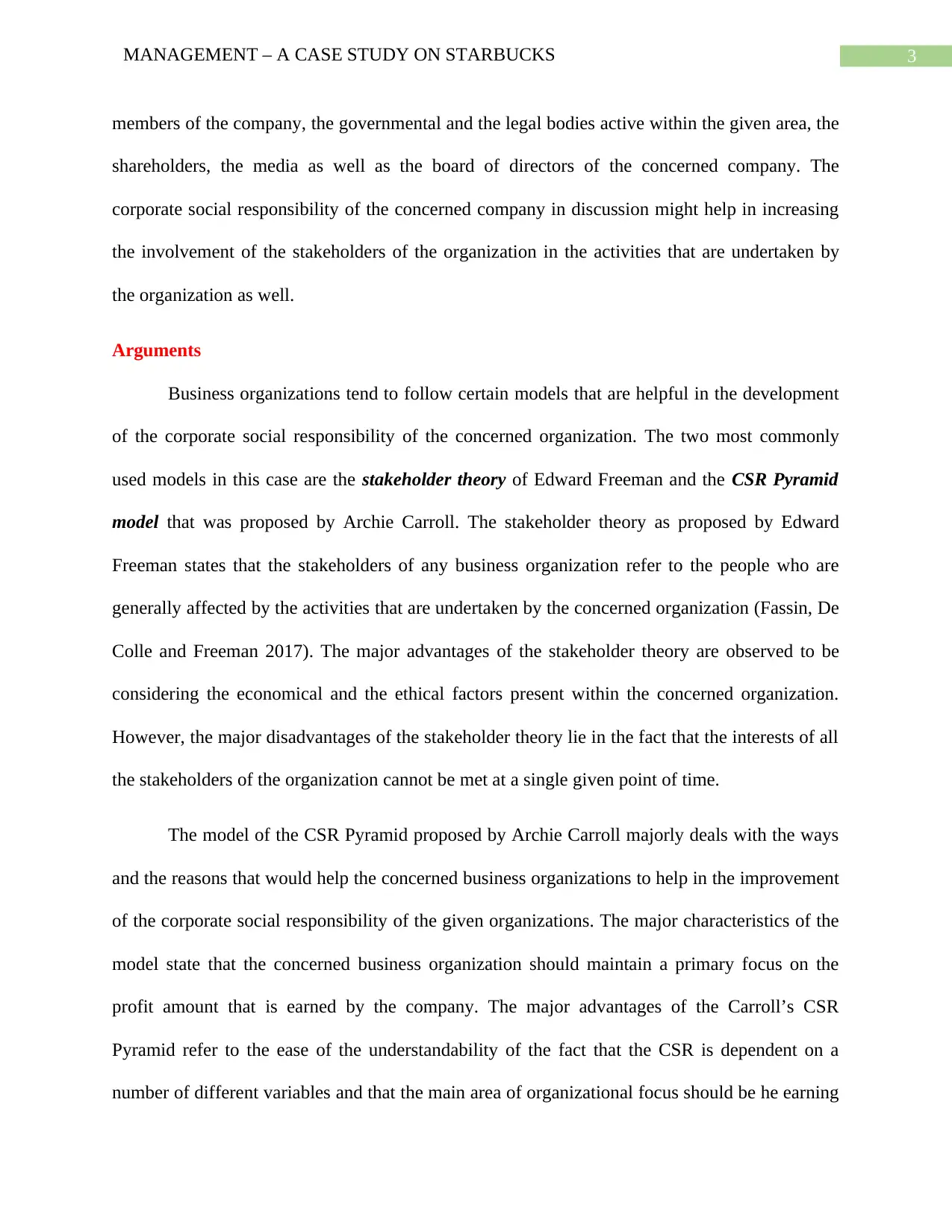
3MANAGEMENT – A CASE STUDY ON STARBUCKS
members of the company, the governmental and the legal bodies active within the given area, the
shareholders, the media as well as the board of directors of the concerned company. The
corporate social responsibility of the concerned company in discussion might help in increasing
the involvement of the stakeholders of the organization in the activities that are undertaken by
the organization as well.
Arguments
Business organizations tend to follow certain models that are helpful in the development
of the corporate social responsibility of the concerned organization. The two most commonly
used models in this case are the stakeholder theory of Edward Freeman and the CSR Pyramid
model that was proposed by Archie Carroll. The stakeholder theory as proposed by Edward
Freeman states that the stakeholders of any business organization refer to the people who are
generally affected by the activities that are undertaken by the concerned organization (Fassin, De
Colle and Freeman 2017). The major advantages of the stakeholder theory are observed to be
considering the economical and the ethical factors present within the concerned organization.
However, the major disadvantages of the stakeholder theory lie in the fact that the interests of all
the stakeholders of the organization cannot be met at a single given point of time.
The model of the CSR Pyramid proposed by Archie Carroll majorly deals with the ways
and the reasons that would help the concerned business organizations to help in the improvement
of the corporate social responsibility of the given organizations. The major characteristics of the
model state that the concerned business organization should maintain a primary focus on the
profit amount that is earned by the company. The major advantages of the Carroll’s CSR
Pyramid refer to the ease of the understandability of the fact that the CSR is dependent on a
number of different variables and that the main area of organizational focus should be he earning
members of the company, the governmental and the legal bodies active within the given area, the
shareholders, the media as well as the board of directors of the concerned company. The
corporate social responsibility of the concerned company in discussion might help in increasing
the involvement of the stakeholders of the organization in the activities that are undertaken by
the organization as well.
Arguments
Business organizations tend to follow certain models that are helpful in the development
of the corporate social responsibility of the concerned organization. The two most commonly
used models in this case are the stakeholder theory of Edward Freeman and the CSR Pyramid
model that was proposed by Archie Carroll. The stakeholder theory as proposed by Edward
Freeman states that the stakeholders of any business organization refer to the people who are
generally affected by the activities that are undertaken by the concerned organization (Fassin, De
Colle and Freeman 2017). The major advantages of the stakeholder theory are observed to be
considering the economical and the ethical factors present within the concerned organization.
However, the major disadvantages of the stakeholder theory lie in the fact that the interests of all
the stakeholders of the organization cannot be met at a single given point of time.
The model of the CSR Pyramid proposed by Archie Carroll majorly deals with the ways
and the reasons that would help the concerned business organizations to help in the improvement
of the corporate social responsibility of the given organizations. The major characteristics of the
model state that the concerned business organization should maintain a primary focus on the
profit amount that is earned by the company. The major advantages of the Carroll’s CSR
Pyramid refer to the ease of the understandability of the fact that the CSR is dependent on a
number of different variables and that the main area of organizational focus should be he earning
Paraphrase This Document
Need a fresh take? Get an instant paraphrase of this document with our AI Paraphraser
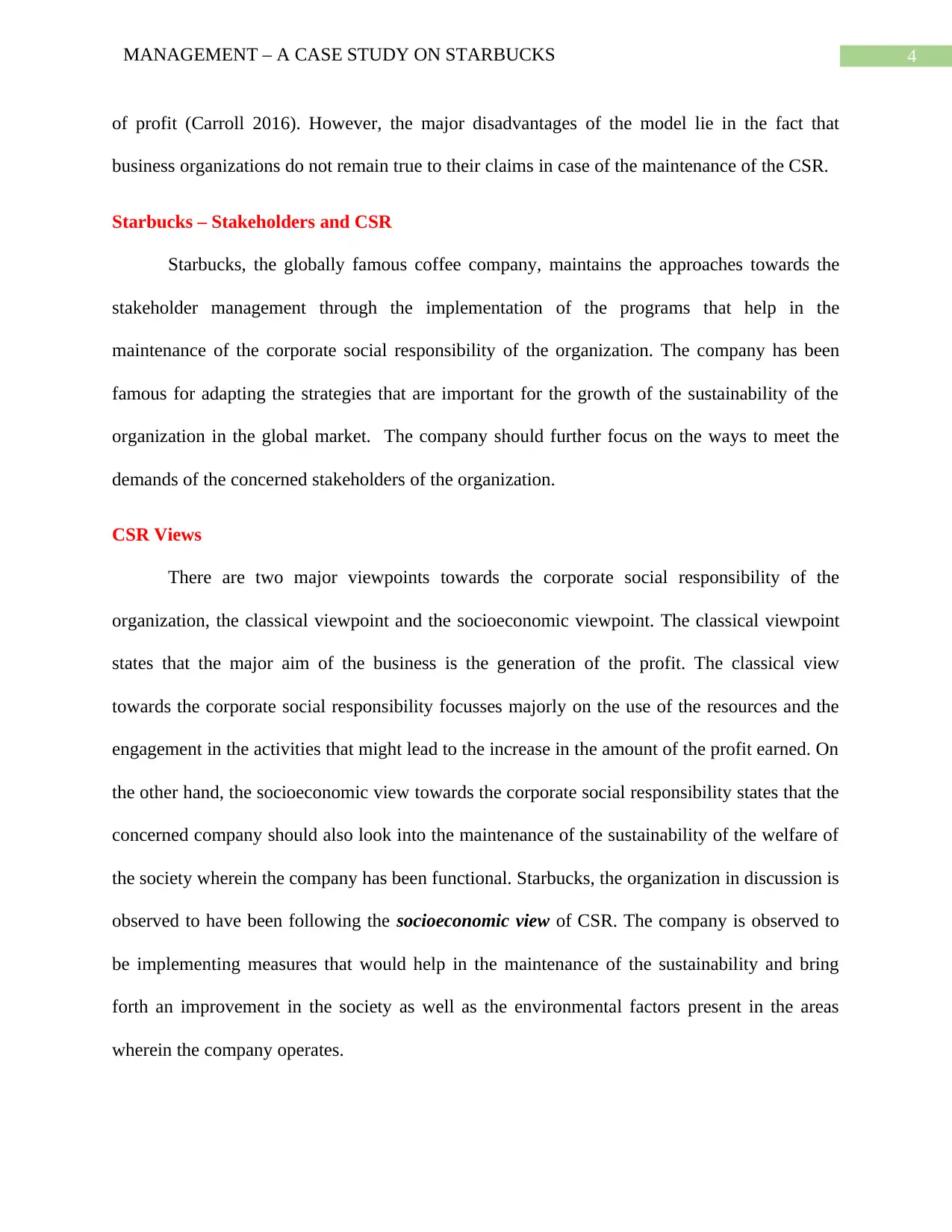
4MANAGEMENT – A CASE STUDY ON STARBUCKS
of profit (Carroll 2016). However, the major disadvantages of the model lie in the fact that
business organizations do not remain true to their claims in case of the maintenance of the CSR.
Starbucks – Stakeholders and CSR
Starbucks, the globally famous coffee company, maintains the approaches towards the
stakeholder management through the implementation of the programs that help in the
maintenance of the corporate social responsibility of the organization. The company has been
famous for adapting the strategies that are important for the growth of the sustainability of the
organization in the global market. The company should further focus on the ways to meet the
demands of the concerned stakeholders of the organization.
CSR Views
There are two major viewpoints towards the corporate social responsibility of the
organization, the classical viewpoint and the socioeconomic viewpoint. The classical viewpoint
states that the major aim of the business is the generation of the profit. The classical view
towards the corporate social responsibility focusses majorly on the use of the resources and the
engagement in the activities that might lead to the increase in the amount of the profit earned. On
the other hand, the socioeconomic view towards the corporate social responsibility states that the
concerned company should also look into the maintenance of the sustainability of the welfare of
the society wherein the company has been functional. Starbucks, the organization in discussion is
observed to have been following the socioeconomic view of CSR. The company is observed to
be implementing measures that would help in the maintenance of the sustainability and bring
forth an improvement in the society as well as the environmental factors present in the areas
wherein the company operates.
of profit (Carroll 2016). However, the major disadvantages of the model lie in the fact that
business organizations do not remain true to their claims in case of the maintenance of the CSR.
Starbucks – Stakeholders and CSR
Starbucks, the globally famous coffee company, maintains the approaches towards the
stakeholder management through the implementation of the programs that help in the
maintenance of the corporate social responsibility of the organization. The company has been
famous for adapting the strategies that are important for the growth of the sustainability of the
organization in the global market. The company should further focus on the ways to meet the
demands of the concerned stakeholders of the organization.
CSR Views
There are two major viewpoints towards the corporate social responsibility of the
organization, the classical viewpoint and the socioeconomic viewpoint. The classical viewpoint
states that the major aim of the business is the generation of the profit. The classical view
towards the corporate social responsibility focusses majorly on the use of the resources and the
engagement in the activities that might lead to the increase in the amount of the profit earned. On
the other hand, the socioeconomic view towards the corporate social responsibility states that the
concerned company should also look into the maintenance of the sustainability of the welfare of
the society wherein the company has been functional. Starbucks, the organization in discussion is
observed to have been following the socioeconomic view of CSR. The company is observed to
be implementing measures that would help in the maintenance of the sustainability and bring
forth an improvement in the society as well as the environmental factors present in the areas
wherein the company operates.
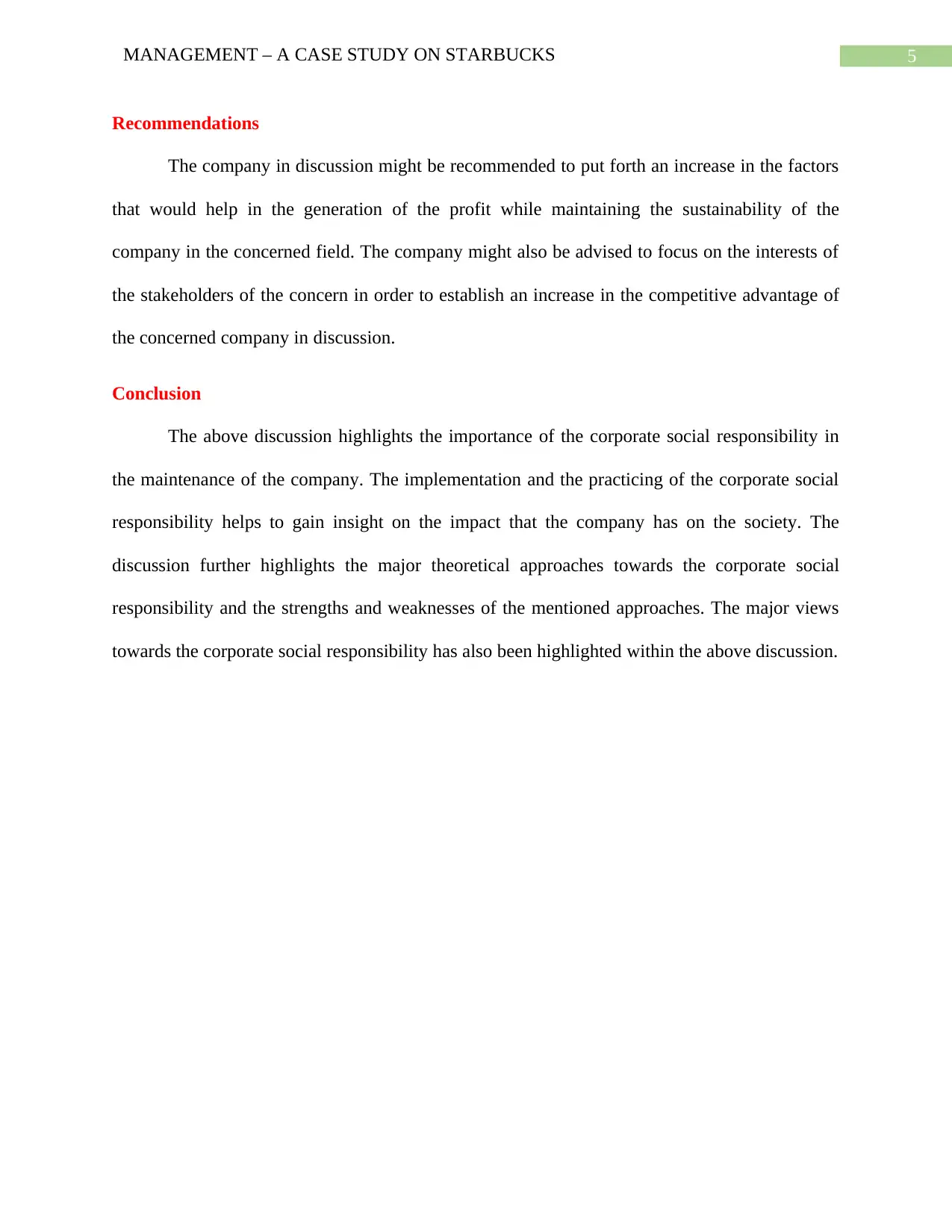
5MANAGEMENT – A CASE STUDY ON STARBUCKS
Recommendations
The company in discussion might be recommended to put forth an increase in the factors
that would help in the generation of the profit while maintaining the sustainability of the
company in the concerned field. The company might also be advised to focus on the interests of
the stakeholders of the concern in order to establish an increase in the competitive advantage of
the concerned company in discussion.
Conclusion
The above discussion highlights the importance of the corporate social responsibility in
the maintenance of the company. The implementation and the practicing of the corporate social
responsibility helps to gain insight on the impact that the company has on the society. The
discussion further highlights the major theoretical approaches towards the corporate social
responsibility and the strengths and weaknesses of the mentioned approaches. The major views
towards the corporate social responsibility has also been highlighted within the above discussion.
Recommendations
The company in discussion might be recommended to put forth an increase in the factors
that would help in the generation of the profit while maintaining the sustainability of the
company in the concerned field. The company might also be advised to focus on the interests of
the stakeholders of the concern in order to establish an increase in the competitive advantage of
the concerned company in discussion.
Conclusion
The above discussion highlights the importance of the corporate social responsibility in
the maintenance of the company. The implementation and the practicing of the corporate social
responsibility helps to gain insight on the impact that the company has on the society. The
discussion further highlights the major theoretical approaches towards the corporate social
responsibility and the strengths and weaknesses of the mentioned approaches. The major views
towards the corporate social responsibility has also been highlighted within the above discussion.
⊘ This is a preview!⊘
Do you want full access?
Subscribe today to unlock all pages.

Trusted by 1+ million students worldwide
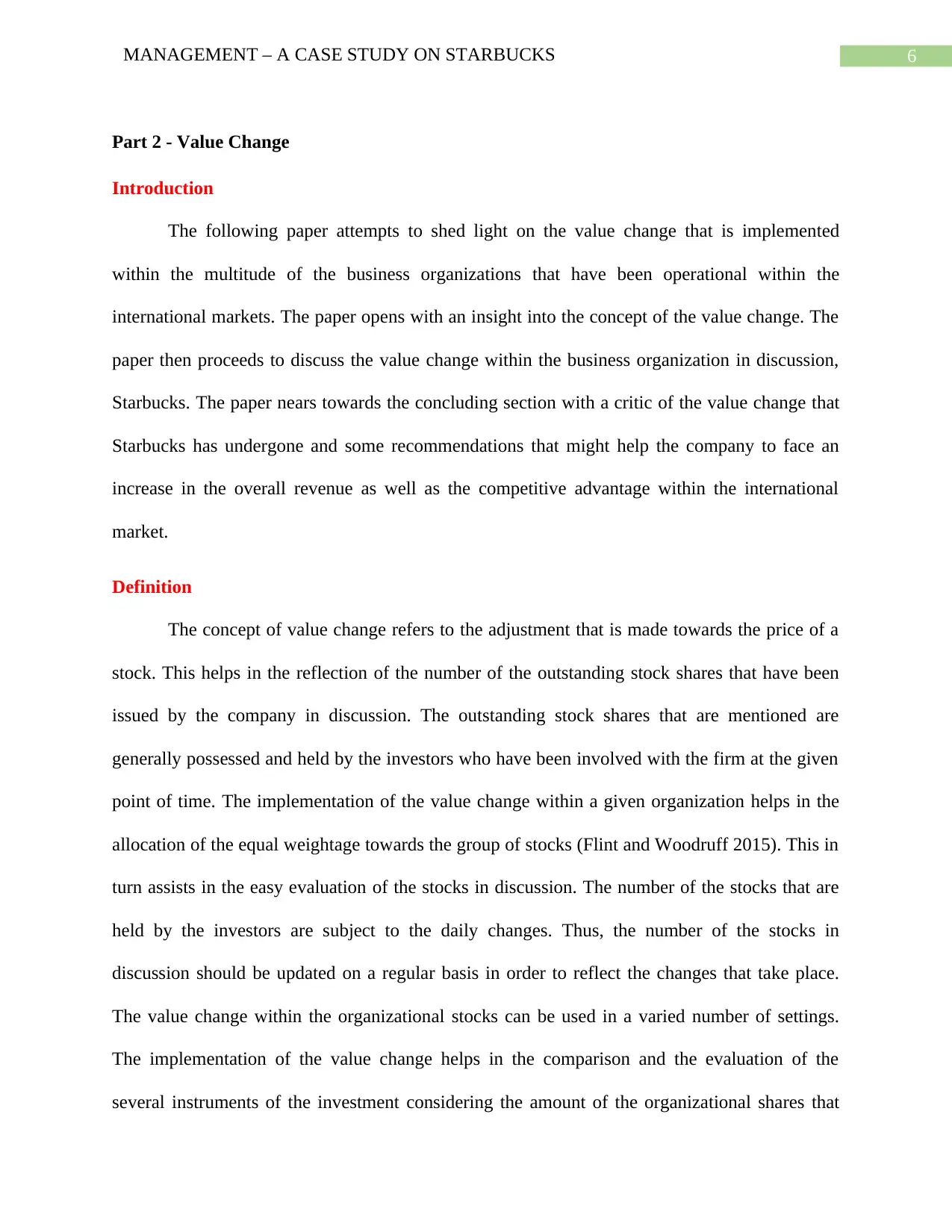
6MANAGEMENT – A CASE STUDY ON STARBUCKS
Part 2 - Value Change
Introduction
The following paper attempts to shed light on the value change that is implemented
within the multitude of the business organizations that have been operational within the
international markets. The paper opens with an insight into the concept of the value change. The
paper then proceeds to discuss the value change within the business organization in discussion,
Starbucks. The paper nears towards the concluding section with a critic of the value change that
Starbucks has undergone and some recommendations that might help the company to face an
increase in the overall revenue as well as the competitive advantage within the international
market.
Definition
The concept of value change refers to the adjustment that is made towards the price of a
stock. This helps in the reflection of the number of the outstanding stock shares that have been
issued by the company in discussion. The outstanding stock shares that are mentioned are
generally possessed and held by the investors who have been involved with the firm at the given
point of time. The implementation of the value change within a given organization helps in the
allocation of the equal weightage towards the group of stocks (Flint and Woodruff 2015). This in
turn assists in the easy evaluation of the stocks in discussion. The number of the stocks that are
held by the investors are subject to the daily changes. Thus, the number of the stocks in
discussion should be updated on a regular basis in order to reflect the changes that take place.
The value change within the organizational stocks can be used in a varied number of settings.
The implementation of the value change helps in the comparison and the evaluation of the
several instruments of the investment considering the amount of the organizational shares that
Part 2 - Value Change
Introduction
The following paper attempts to shed light on the value change that is implemented
within the multitude of the business organizations that have been operational within the
international markets. The paper opens with an insight into the concept of the value change. The
paper then proceeds to discuss the value change within the business organization in discussion,
Starbucks. The paper nears towards the concluding section with a critic of the value change that
Starbucks has undergone and some recommendations that might help the company to face an
increase in the overall revenue as well as the competitive advantage within the international
market.
Definition
The concept of value change refers to the adjustment that is made towards the price of a
stock. This helps in the reflection of the number of the outstanding stock shares that have been
issued by the company in discussion. The outstanding stock shares that are mentioned are
generally possessed and held by the investors who have been involved with the firm at the given
point of time. The implementation of the value change within a given organization helps in the
allocation of the equal weightage towards the group of stocks (Flint and Woodruff 2015). This in
turn assists in the easy evaluation of the stocks in discussion. The number of the stocks that are
held by the investors are subject to the daily changes. Thus, the number of the stocks in
discussion should be updated on a regular basis in order to reflect the changes that take place.
The value change within the organizational stocks can be used in a varied number of settings.
The implementation of the value change helps in the comparison and the evaluation of the
several instruments of the investment considering the amount of the organizational shares that
Paraphrase This Document
Need a fresh take? Get an instant paraphrase of this document with our AI Paraphraser
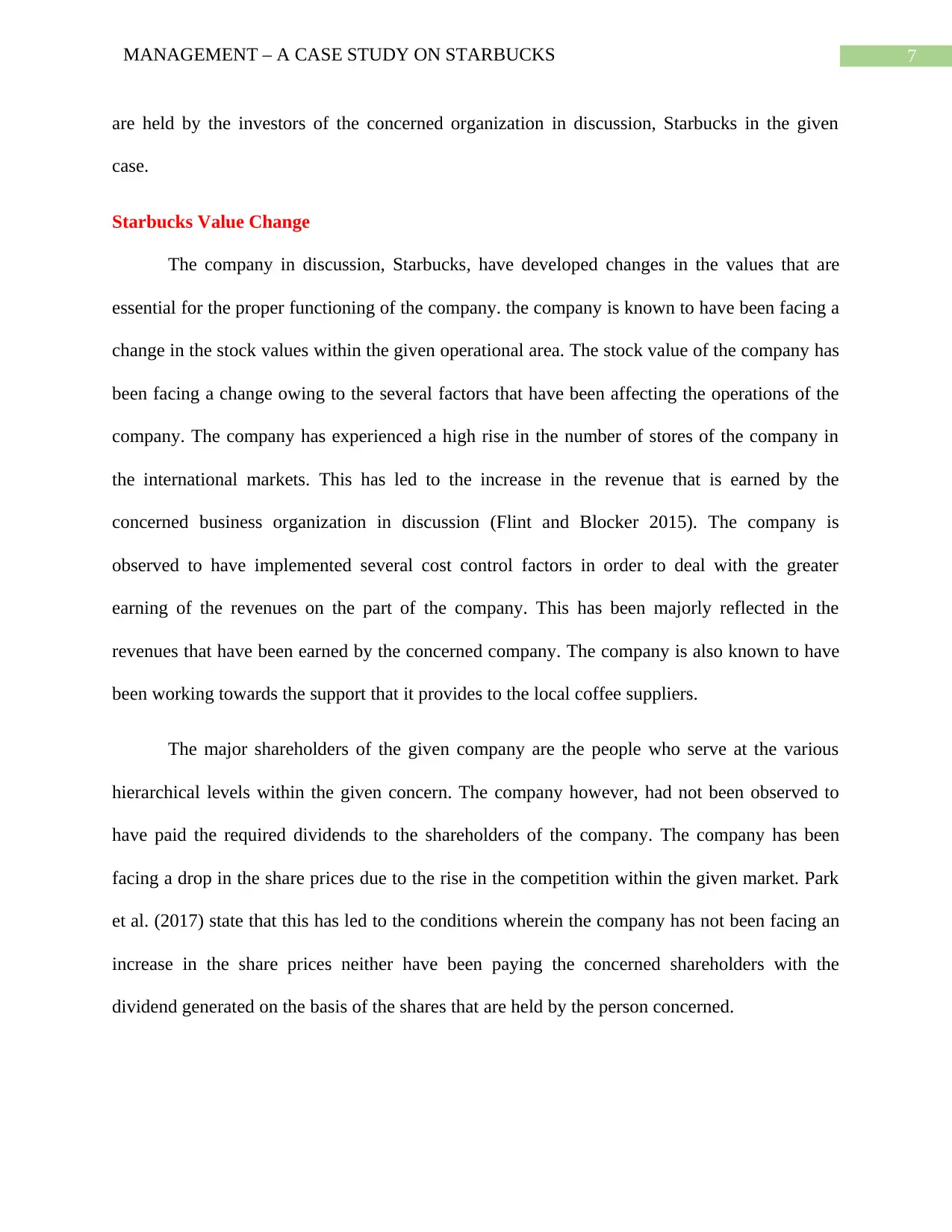
7MANAGEMENT – A CASE STUDY ON STARBUCKS
are held by the investors of the concerned organization in discussion, Starbucks in the given
case.
Starbucks Value Change
The company in discussion, Starbucks, have developed changes in the values that are
essential for the proper functioning of the company. the company is known to have been facing a
change in the stock values within the given operational area. The stock value of the company has
been facing a change owing to the several factors that have been affecting the operations of the
company. The company has experienced a high rise in the number of stores of the company in
the international markets. This has led to the increase in the revenue that is earned by the
concerned business organization in discussion (Flint and Blocker 2015). The company is
observed to have implemented several cost control factors in order to deal with the greater
earning of the revenues on the part of the company. This has been majorly reflected in the
revenues that have been earned by the concerned company. The company is also known to have
been working towards the support that it provides to the local coffee suppliers.
The major shareholders of the given company are the people who serve at the various
hierarchical levels within the given concern. The company however, had not been observed to
have paid the required dividends to the shareholders of the company. The company has been
facing a drop in the share prices due to the rise in the competition within the given market. Park
et al. (2017) state that this has led to the conditions wherein the company has not been facing an
increase in the share prices neither have been paying the concerned shareholders with the
dividend generated on the basis of the shares that are held by the person concerned.
are held by the investors of the concerned organization in discussion, Starbucks in the given
case.
Starbucks Value Change
The company in discussion, Starbucks, have developed changes in the values that are
essential for the proper functioning of the company. the company is known to have been facing a
change in the stock values within the given operational area. The stock value of the company has
been facing a change owing to the several factors that have been affecting the operations of the
company. The company has experienced a high rise in the number of stores of the company in
the international markets. This has led to the increase in the revenue that is earned by the
concerned business organization in discussion (Flint and Blocker 2015). The company is
observed to have implemented several cost control factors in order to deal with the greater
earning of the revenues on the part of the company. This has been majorly reflected in the
revenues that have been earned by the concerned company. The company is also known to have
been working towards the support that it provides to the local coffee suppliers.
The major shareholders of the given company are the people who serve at the various
hierarchical levels within the given concern. The company however, had not been observed to
have paid the required dividends to the shareholders of the company. The company has been
facing a drop in the share prices due to the rise in the competition within the given market. Park
et al. (2017) state that this has led to the conditions wherein the company has not been facing an
increase in the share prices neither have been paying the concerned shareholders with the
dividend generated on the basis of the shares that are held by the person concerned.
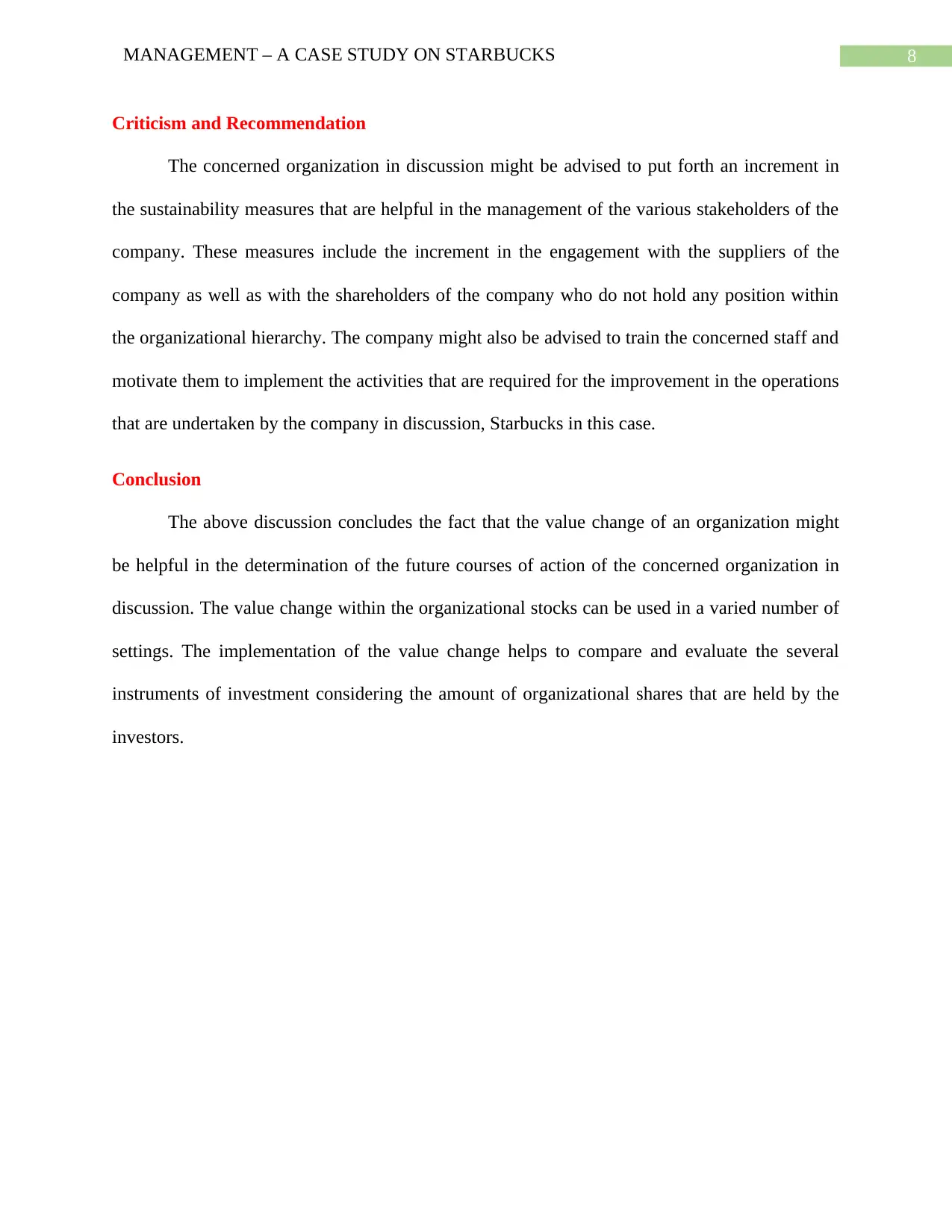
8MANAGEMENT – A CASE STUDY ON STARBUCKS
Criticism and Recommendation
The concerned organization in discussion might be advised to put forth an increment in
the sustainability measures that are helpful in the management of the various stakeholders of the
company. These measures include the increment in the engagement with the suppliers of the
company as well as with the shareholders of the company who do not hold any position within
the organizational hierarchy. The company might also be advised to train the concerned staff and
motivate them to implement the activities that are required for the improvement in the operations
that are undertaken by the company in discussion, Starbucks in this case.
Conclusion
The above discussion concludes the fact that the value change of an organization might
be helpful in the determination of the future courses of action of the concerned organization in
discussion. The value change within the organizational stocks can be used in a varied number of
settings. The implementation of the value change helps to compare and evaluate the several
instruments of investment considering the amount of organizational shares that are held by the
investors.
Criticism and Recommendation
The concerned organization in discussion might be advised to put forth an increment in
the sustainability measures that are helpful in the management of the various stakeholders of the
company. These measures include the increment in the engagement with the suppliers of the
company as well as with the shareholders of the company who do not hold any position within
the organizational hierarchy. The company might also be advised to train the concerned staff and
motivate them to implement the activities that are required for the improvement in the operations
that are undertaken by the company in discussion, Starbucks in this case.
Conclusion
The above discussion concludes the fact that the value change of an organization might
be helpful in the determination of the future courses of action of the concerned organization in
discussion. The value change within the organizational stocks can be used in a varied number of
settings. The implementation of the value change helps to compare and evaluate the several
instruments of investment considering the amount of organizational shares that are held by the
investors.
⊘ This is a preview!⊘
Do you want full access?
Subscribe today to unlock all pages.

Trusted by 1+ million students worldwide
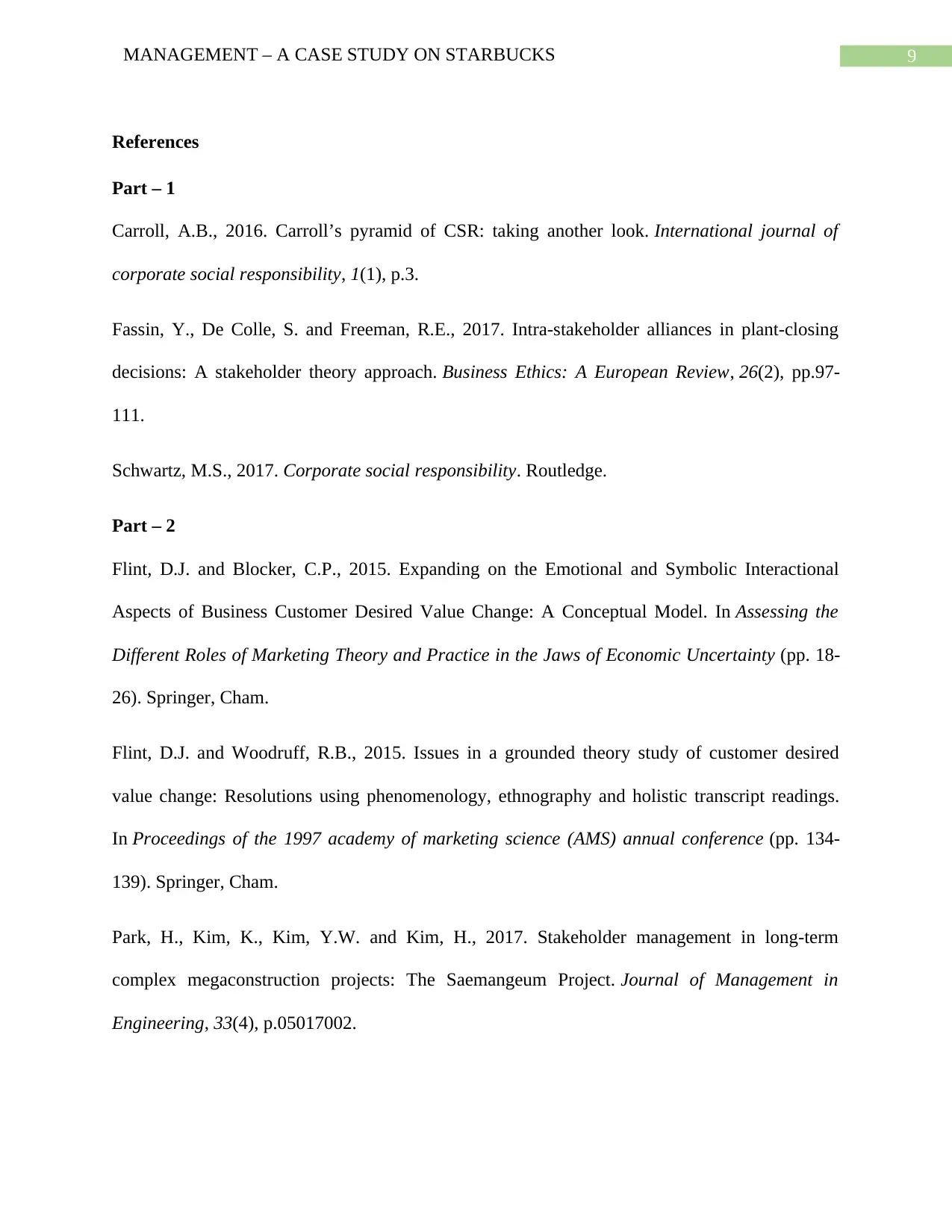
9MANAGEMENT – A CASE STUDY ON STARBUCKS
References
Part – 1
Carroll, A.B., 2016. Carroll’s pyramid of CSR: taking another look. International journal of
corporate social responsibility, 1(1), p.3.
Fassin, Y., De Colle, S. and Freeman, R.E., 2017. Intra‐stakeholder alliances in plant‐closing
decisions: A stakeholder theory approach. Business Ethics: A European Review, 26(2), pp.97-
111.
Schwartz, M.S., 2017. Corporate social responsibility. Routledge.
Part – 2
Flint, D.J. and Blocker, C.P., 2015. Expanding on the Emotional and Symbolic Interactional
Aspects of Business Customer Desired Value Change: A Conceptual Model. In Assessing the
Different Roles of Marketing Theory and Practice in the Jaws of Economic Uncertainty (pp. 18-
26). Springer, Cham.
Flint, D.J. and Woodruff, R.B., 2015. Issues in a grounded theory study of customer desired
value change: Resolutions using phenomenology, ethnography and holistic transcript readings.
In Proceedings of the 1997 academy of marketing science (AMS) annual conference (pp. 134-
139). Springer, Cham.
Park, H., Kim, K., Kim, Y.W. and Kim, H., 2017. Stakeholder management in long-term
complex megaconstruction projects: The Saemangeum Project. Journal of Management in
Engineering, 33(4), p.05017002.
References
Part – 1
Carroll, A.B., 2016. Carroll’s pyramid of CSR: taking another look. International journal of
corporate social responsibility, 1(1), p.3.
Fassin, Y., De Colle, S. and Freeman, R.E., 2017. Intra‐stakeholder alliances in plant‐closing
decisions: A stakeholder theory approach. Business Ethics: A European Review, 26(2), pp.97-
111.
Schwartz, M.S., 2017. Corporate social responsibility. Routledge.
Part – 2
Flint, D.J. and Blocker, C.P., 2015. Expanding on the Emotional and Symbolic Interactional
Aspects of Business Customer Desired Value Change: A Conceptual Model. In Assessing the
Different Roles of Marketing Theory and Practice in the Jaws of Economic Uncertainty (pp. 18-
26). Springer, Cham.
Flint, D.J. and Woodruff, R.B., 2015. Issues in a grounded theory study of customer desired
value change: Resolutions using phenomenology, ethnography and holistic transcript readings.
In Proceedings of the 1997 academy of marketing science (AMS) annual conference (pp. 134-
139). Springer, Cham.
Park, H., Kim, K., Kim, Y.W. and Kim, H., 2017. Stakeholder management in long-term
complex megaconstruction projects: The Saemangeum Project. Journal of Management in
Engineering, 33(4), p.05017002.
1 out of 10
Related Documents
Your All-in-One AI-Powered Toolkit for Academic Success.
+13062052269
info@desklib.com
Available 24*7 on WhatsApp / Email
![[object Object]](/_next/static/media/star-bottom.7253800d.svg)
Unlock your academic potential
Copyright © 2020–2025 A2Z Services. All Rights Reserved. Developed and managed by ZUCOL.





